Holistic Health Assessment in Aged Care
VerifiedAdded on 2020/04/01
|7
|1846
|38
Essay
AI Summary
The essay discusses the holistic health assessment approach in aged care, highlighting its benefits for both patients and healthcare providers. It emphasizes the importance of person-centered care planning, which allows elderly individuals to actively participate in their care decisions. The paper outlines various aspects of holistic assessments, including physiological, sociological, psychological, spiritual, cultural, and developmental factors. It also addresses the significance of understanding cultural contexts and the role of person-centered care in enhancing the quality of life for older adults. The conclusion reinforces the need for healthcare professionals to adopt these approaches to empower elderly patients and improve their overall well-being.
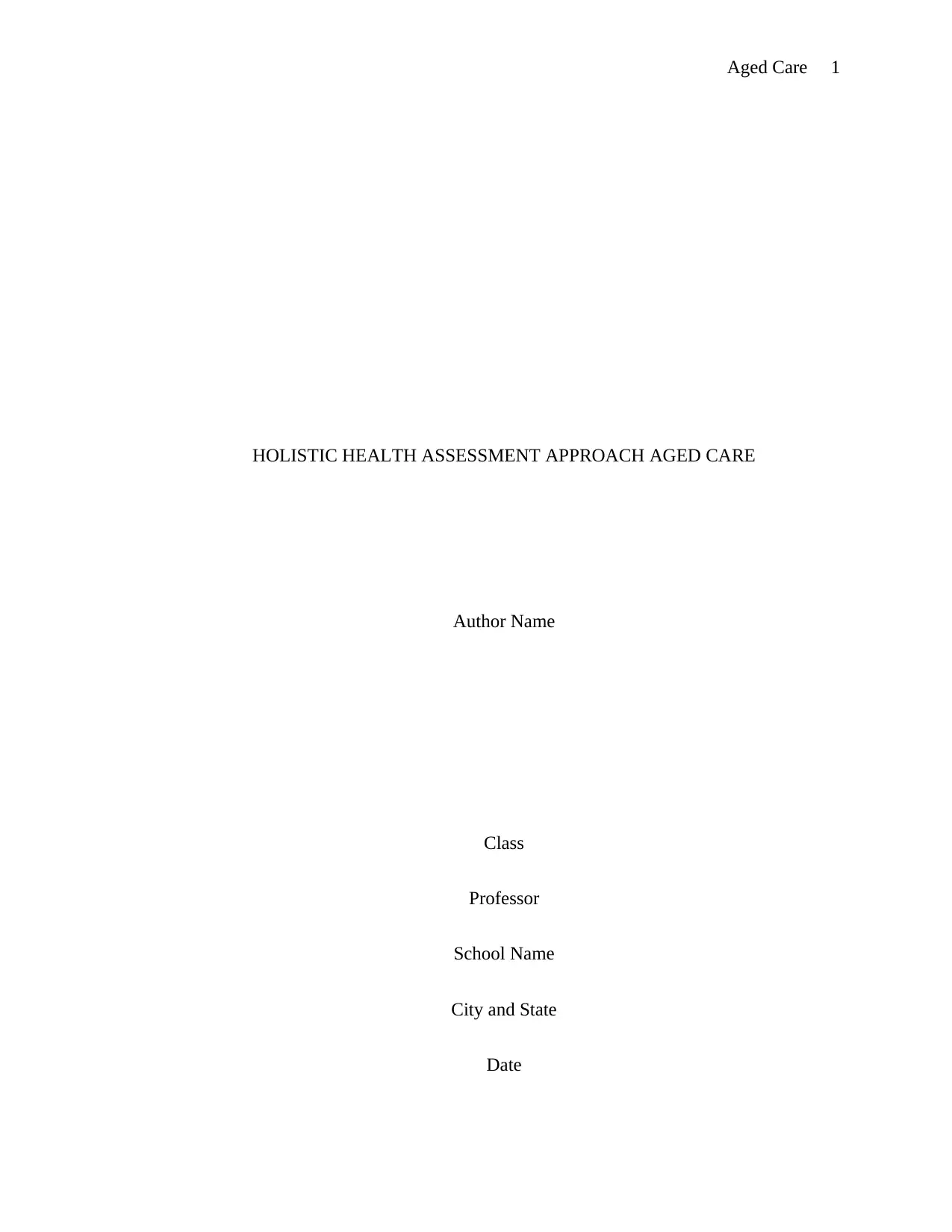
Aged Care 1
HOLISTIC HEALTH ASSESSMENT APPROACH AGED CARE
Author Name
Class
Professor
School Name
City and State
Date
HOLISTIC HEALTH ASSESSMENT APPROACH AGED CARE
Author Name
Class
Professor
School Name
City and State
Date
Paraphrase This Document
Need a fresh take? Get an instant paraphrase of this document with our AI Paraphraser
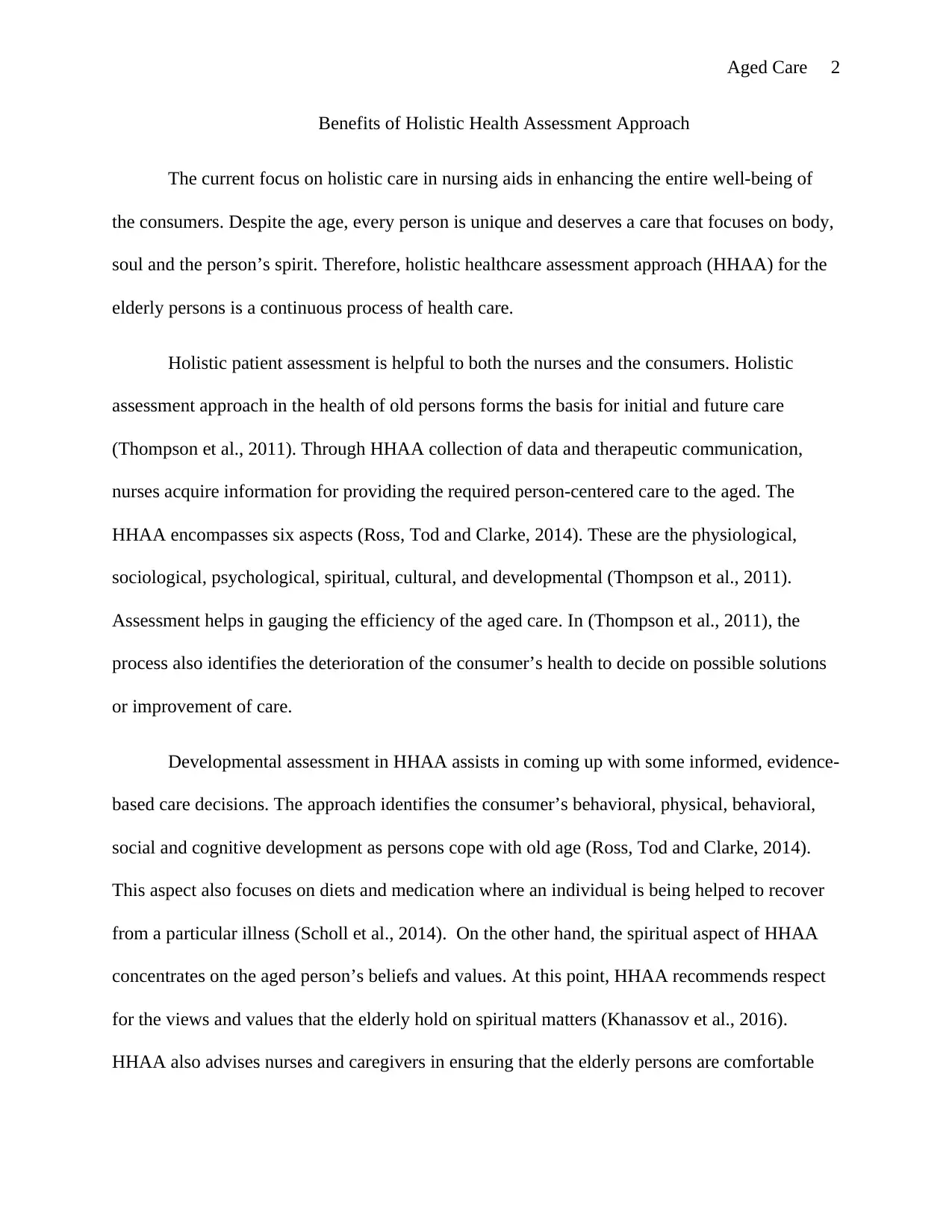
Aged Care 2
Benefits of Holistic Health Assessment Approach
The current focus on holistic care in nursing aids in enhancing the entire well-being of
the consumers. Despite the age, every person is unique and deserves a care that focuses on body,
soul and the person’s spirit. Therefore, holistic healthcare assessment approach (HHAA) for the
elderly persons is a continuous process of health care.
Holistic patient assessment is helpful to both the nurses and the consumers. Holistic
assessment approach in the health of old persons forms the basis for initial and future care
(Thompson et al., 2011). Through HHAA collection of data and therapeutic communication,
nurses acquire information for providing the required person-centered care to the aged. The
HHAA encompasses six aspects (Ross, Tod and Clarke, 2014). These are the physiological,
sociological, psychological, spiritual, cultural, and developmental (Thompson et al., 2011).
Assessment helps in gauging the efficiency of the aged care. In (Thompson et al., 2011), the
process also identifies the deterioration of the consumer’s health to decide on possible solutions
or improvement of care.
Developmental assessment in HHAA assists in coming up with some informed, evidence-
based care decisions. The approach identifies the consumer’s behavioral, physical, behavioral,
social and cognitive development as persons cope with old age (Ross, Tod and Clarke, 2014).
This aspect also focuses on diets and medication where an individual is being helped to recover
from a particular illness (Scholl et al., 2014). On the other hand, the spiritual aspect of HHAA
concentrates on the aged person’s beliefs and values. At this point, HHAA recommends respect
for the views and values that the elderly hold on spiritual matters (Khanassov et al., 2016).
HHAA also advises nurses and caregivers in ensuring that the elderly persons are comfortable
Benefits of Holistic Health Assessment Approach
The current focus on holistic care in nursing aids in enhancing the entire well-being of
the consumers. Despite the age, every person is unique and deserves a care that focuses on body,
soul and the person’s spirit. Therefore, holistic healthcare assessment approach (HHAA) for the
elderly persons is a continuous process of health care.
Holistic patient assessment is helpful to both the nurses and the consumers. Holistic
assessment approach in the health of old persons forms the basis for initial and future care
(Thompson et al., 2011). Through HHAA collection of data and therapeutic communication,
nurses acquire information for providing the required person-centered care to the aged. The
HHAA encompasses six aspects (Ross, Tod and Clarke, 2014). These are the physiological,
sociological, psychological, spiritual, cultural, and developmental (Thompson et al., 2011).
Assessment helps in gauging the efficiency of the aged care. In (Thompson et al., 2011), the
process also identifies the deterioration of the consumer’s health to decide on possible solutions
or improvement of care.
Developmental assessment in HHAA assists in coming up with some informed, evidence-
based care decisions. The approach identifies the consumer’s behavioral, physical, behavioral,
social and cognitive development as persons cope with old age (Ross, Tod and Clarke, 2014).
This aspect also focuses on diets and medication where an individual is being helped to recover
from a particular illness (Scholl et al., 2014). On the other hand, the spiritual aspect of HHAA
concentrates on the aged person’s beliefs and values. At this point, HHAA recommends respect
for the views and values that the elderly hold on spiritual matters (Khanassov et al., 2016).
HHAA also advises nurses and caregivers in ensuring that the elderly persons are comfortable
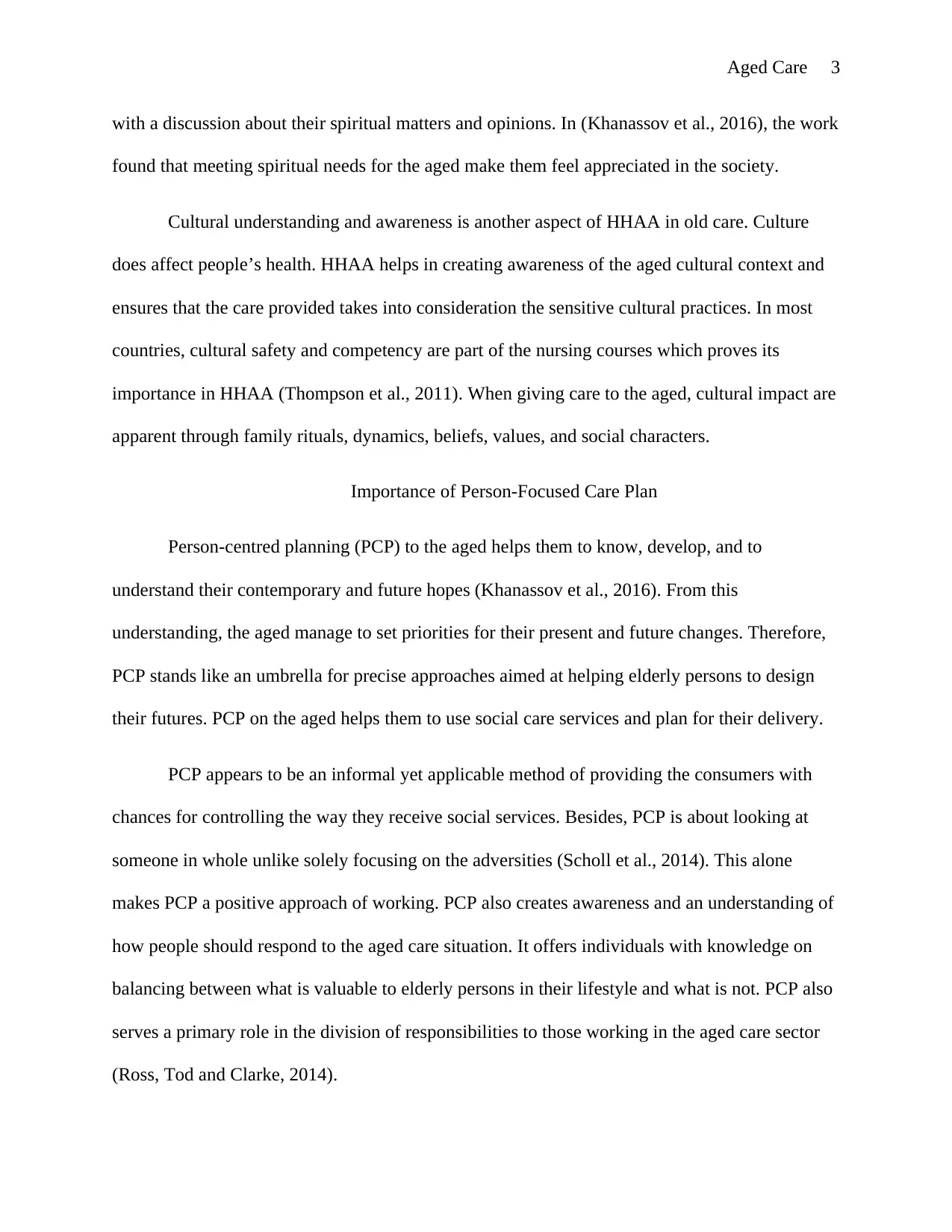
Aged Care 3
with a discussion about their spiritual matters and opinions. In (Khanassov et al., 2016), the work
found that meeting spiritual needs for the aged make them feel appreciated in the society.
Cultural understanding and awareness is another aspect of HHAA in old care. Culture
does affect people’s health. HHAA helps in creating awareness of the aged cultural context and
ensures that the care provided takes into consideration the sensitive cultural practices. In most
countries, cultural safety and competency are part of the nursing courses which proves its
importance in HHAA (Thompson et al., 2011). When giving care to the aged, cultural impact are
apparent through family rituals, dynamics, beliefs, values, and social characters.
Importance of Person-Focused Care Plan
Person-centred planning (PCP) to the aged helps them to know, develop, and to
understand their contemporary and future hopes (Khanassov et al., 2016). From this
understanding, the aged manage to set priorities for their present and future changes. Therefore,
PCP stands like an umbrella for precise approaches aimed at helping elderly persons to design
their futures. PCP on the aged helps them to use social care services and plan for their delivery.
PCP appears to be an informal yet applicable method of providing the consumers with
chances for controlling the way they receive social services. Besides, PCP is about looking at
someone in whole unlike solely focusing on the adversities (Scholl et al., 2014). This alone
makes PCP a positive approach of working. PCP also creates awareness and an understanding of
how people should respond to the aged care situation. It offers individuals with knowledge on
balancing between what is valuable to elderly persons in their lifestyle and what is not. PCP also
serves a primary role in the division of responsibilities to those working in the aged care sector
(Ross, Tod and Clarke, 2014).
with a discussion about their spiritual matters and opinions. In (Khanassov et al., 2016), the work
found that meeting spiritual needs for the aged make them feel appreciated in the society.
Cultural understanding and awareness is another aspect of HHAA in old care. Culture
does affect people’s health. HHAA helps in creating awareness of the aged cultural context and
ensures that the care provided takes into consideration the sensitive cultural practices. In most
countries, cultural safety and competency are part of the nursing courses which proves its
importance in HHAA (Thompson et al., 2011). When giving care to the aged, cultural impact are
apparent through family rituals, dynamics, beliefs, values, and social characters.
Importance of Person-Focused Care Plan
Person-centred planning (PCP) to the aged helps them to know, develop, and to
understand their contemporary and future hopes (Khanassov et al., 2016). From this
understanding, the aged manage to set priorities for their present and future changes. Therefore,
PCP stands like an umbrella for precise approaches aimed at helping elderly persons to design
their futures. PCP on the aged helps them to use social care services and plan for their delivery.
PCP appears to be an informal yet applicable method of providing the consumers with
chances for controlling the way they receive social services. Besides, PCP is about looking at
someone in whole unlike solely focusing on the adversities (Scholl et al., 2014). This alone
makes PCP a positive approach of working. PCP also creates awareness and an understanding of
how people should respond to the aged care situation. It offers individuals with knowledge on
balancing between what is valuable to elderly persons in their lifestyle and what is not. PCP also
serves a primary role in the division of responsibilities to those working in the aged care sector
(Ross, Tod and Clarke, 2014).
⊘ This is a preview!⊘
Do you want full access?
Subscribe today to unlock all pages.

Trusted by 1+ million students worldwide
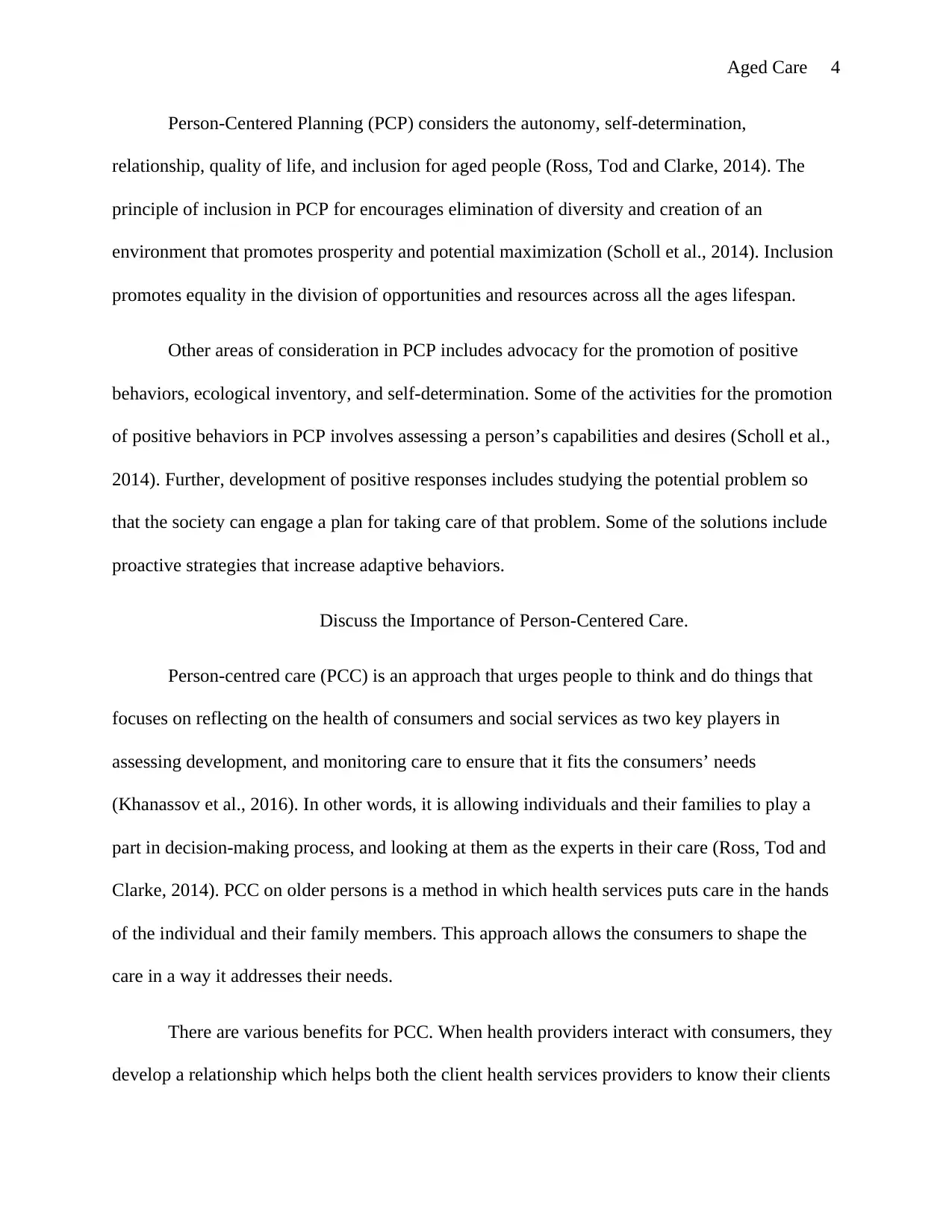
Aged Care 4
Person-Centered Planning (PCP) considers the autonomy, self-determination,
relationship, quality of life, and inclusion for aged people (Ross, Tod and Clarke, 2014). The
principle of inclusion in PCP for encourages elimination of diversity and creation of an
environment that promotes prosperity and potential maximization (Scholl et al., 2014). Inclusion
promotes equality in the division of opportunities and resources across all the ages lifespan.
Other areas of consideration in PCP includes advocacy for the promotion of positive
behaviors, ecological inventory, and self-determination. Some of the activities for the promotion
of positive behaviors in PCP involves assessing a person’s capabilities and desires (Scholl et al.,
2014). Further, development of positive responses includes studying the potential problem so
that the society can engage a plan for taking care of that problem. Some of the solutions include
proactive strategies that increase adaptive behaviors.
Discuss the Importance of Person-Centered Care.
Person-centred care (PCC) is an approach that urges people to think and do things that
focuses on reflecting on the health of consumers and social services as two key players in
assessing development, and monitoring care to ensure that it fits the consumers’ needs
(Khanassov et al., 2016). In other words, it is allowing individuals and their families to play a
part in decision-making process, and looking at them as the experts in their care (Ross, Tod and
Clarke, 2014). PCC on older persons is a method in which health services puts care in the hands
of the individual and their family members. This approach allows the consumers to shape the
care in a way it addresses their needs.
There are various benefits for PCC. When health providers interact with consumers, they
develop a relationship which helps both the client health services providers to know their clients
Person-Centered Planning (PCP) considers the autonomy, self-determination,
relationship, quality of life, and inclusion for aged people (Ross, Tod and Clarke, 2014). The
principle of inclusion in PCP for encourages elimination of diversity and creation of an
environment that promotes prosperity and potential maximization (Scholl et al., 2014). Inclusion
promotes equality in the division of opportunities and resources across all the ages lifespan.
Other areas of consideration in PCP includes advocacy for the promotion of positive
behaviors, ecological inventory, and self-determination. Some of the activities for the promotion
of positive behaviors in PCP involves assessing a person’s capabilities and desires (Scholl et al.,
2014). Further, development of positive responses includes studying the potential problem so
that the society can engage a plan for taking care of that problem. Some of the solutions include
proactive strategies that increase adaptive behaviors.
Discuss the Importance of Person-Centered Care.
Person-centred care (PCC) is an approach that urges people to think and do things that
focuses on reflecting on the health of consumers and social services as two key players in
assessing development, and monitoring care to ensure that it fits the consumers’ needs
(Khanassov et al., 2016). In other words, it is allowing individuals and their families to play a
part in decision-making process, and looking at them as the experts in their care (Ross, Tod and
Clarke, 2014). PCC on older persons is a method in which health services puts care in the hands
of the individual and their family members. This approach allows the consumers to shape the
care in a way it addresses their needs.
There are various benefits for PCC. When health providers interact with consumers, they
develop a relationship which helps both the client health services providers to know their clients
Paraphrase This Document
Need a fresh take? Get an instant paraphrase of this document with our AI Paraphraser
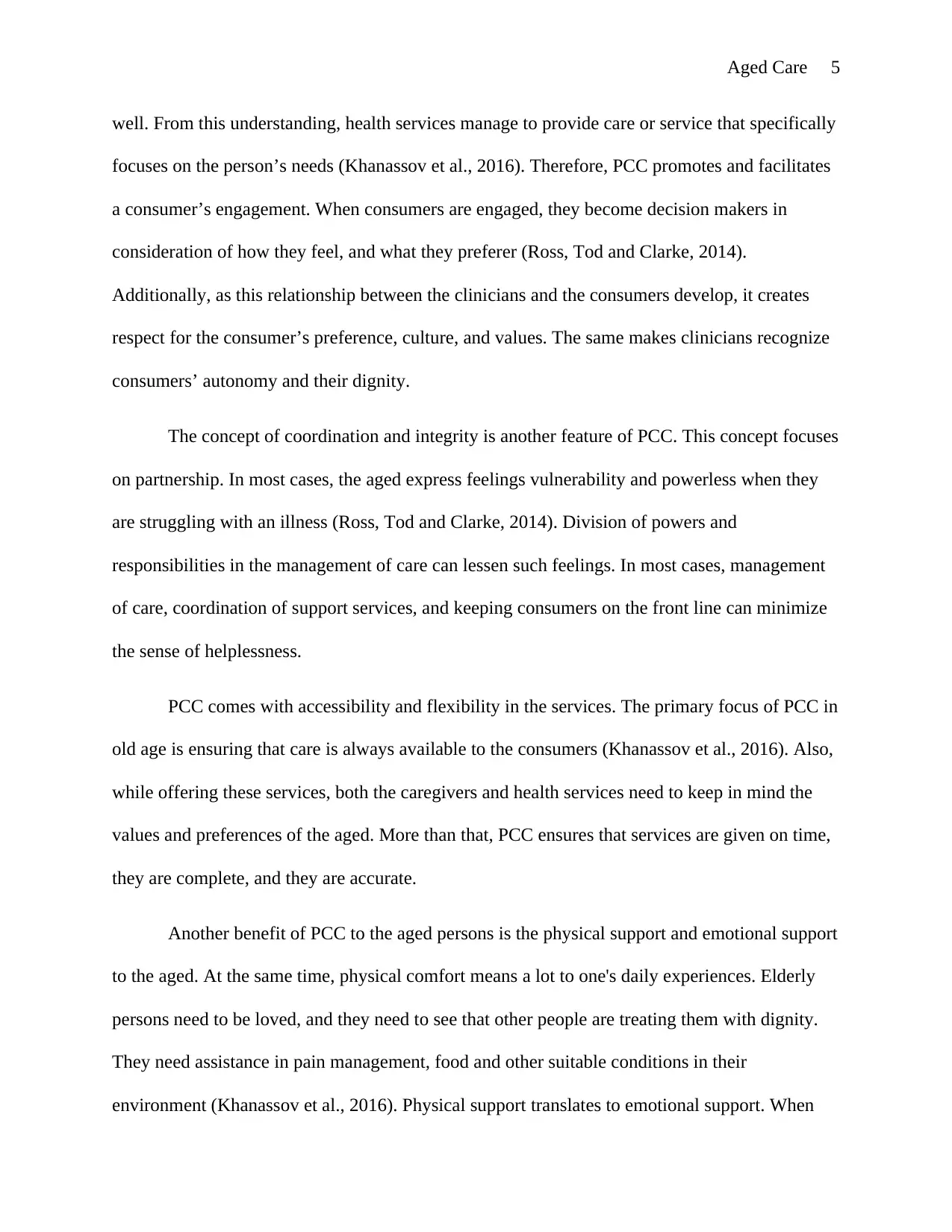
Aged Care 5
well. From this understanding, health services manage to provide care or service that specifically
focuses on the person’s needs (Khanassov et al., 2016). Therefore, PCC promotes and facilitates
a consumer’s engagement. When consumers are engaged, they become decision makers in
consideration of how they feel, and what they preferer (Ross, Tod and Clarke, 2014).
Additionally, as this relationship between the clinicians and the consumers develop, it creates
respect for the consumer’s preference, culture, and values. The same makes clinicians recognize
consumers’ autonomy and their dignity.
The concept of coordination and integrity is another feature of PCC. This concept focuses
on partnership. In most cases, the aged express feelings vulnerability and powerless when they
are struggling with an illness (Ross, Tod and Clarke, 2014). Division of powers and
responsibilities in the management of care can lessen such feelings. In most cases, management
of care, coordination of support services, and keeping consumers on the front line can minimize
the sense of helplessness.
PCC comes with accessibility and flexibility in the services. The primary focus of PCC in
old age is ensuring that care is always available to the consumers (Khanassov et al., 2016). Also,
while offering these services, both the caregivers and health services need to keep in mind the
values and preferences of the aged. More than that, PCC ensures that services are given on time,
they are complete, and they are accurate.
Another benefit of PCC to the aged persons is the physical support and emotional support
to the aged. At the same time, physical comfort means a lot to one's daily experiences. Elderly
persons need to be loved, and they need to see that other people are treating them with dignity.
They need assistance in pain management, food and other suitable conditions in their
environment (Khanassov et al., 2016). Physical support translates to emotional support. When
well. From this understanding, health services manage to provide care or service that specifically
focuses on the person’s needs (Khanassov et al., 2016). Therefore, PCC promotes and facilitates
a consumer’s engagement. When consumers are engaged, they become decision makers in
consideration of how they feel, and what they preferer (Ross, Tod and Clarke, 2014).
Additionally, as this relationship between the clinicians and the consumers develop, it creates
respect for the consumer’s preference, culture, and values. The same makes clinicians recognize
consumers’ autonomy and their dignity.
The concept of coordination and integrity is another feature of PCC. This concept focuses
on partnership. In most cases, the aged express feelings vulnerability and powerless when they
are struggling with an illness (Ross, Tod and Clarke, 2014). Division of powers and
responsibilities in the management of care can lessen such feelings. In most cases, management
of care, coordination of support services, and keeping consumers on the front line can minimize
the sense of helplessness.
PCC comes with accessibility and flexibility in the services. The primary focus of PCC in
old age is ensuring that care is always available to the consumers (Khanassov et al., 2016). Also,
while offering these services, both the caregivers and health services need to keep in mind the
values and preferences of the aged. More than that, PCC ensures that services are given on time,
they are complete, and they are accurate.
Another benefit of PCC to the aged persons is the physical support and emotional support
to the aged. At the same time, physical comfort means a lot to one's daily experiences. Elderly
persons need to be loved, and they need to see that other people are treating them with dignity.
They need assistance in pain management, food and other suitable conditions in their
environment (Khanassov et al., 2016). Physical support translates to emotional support. When
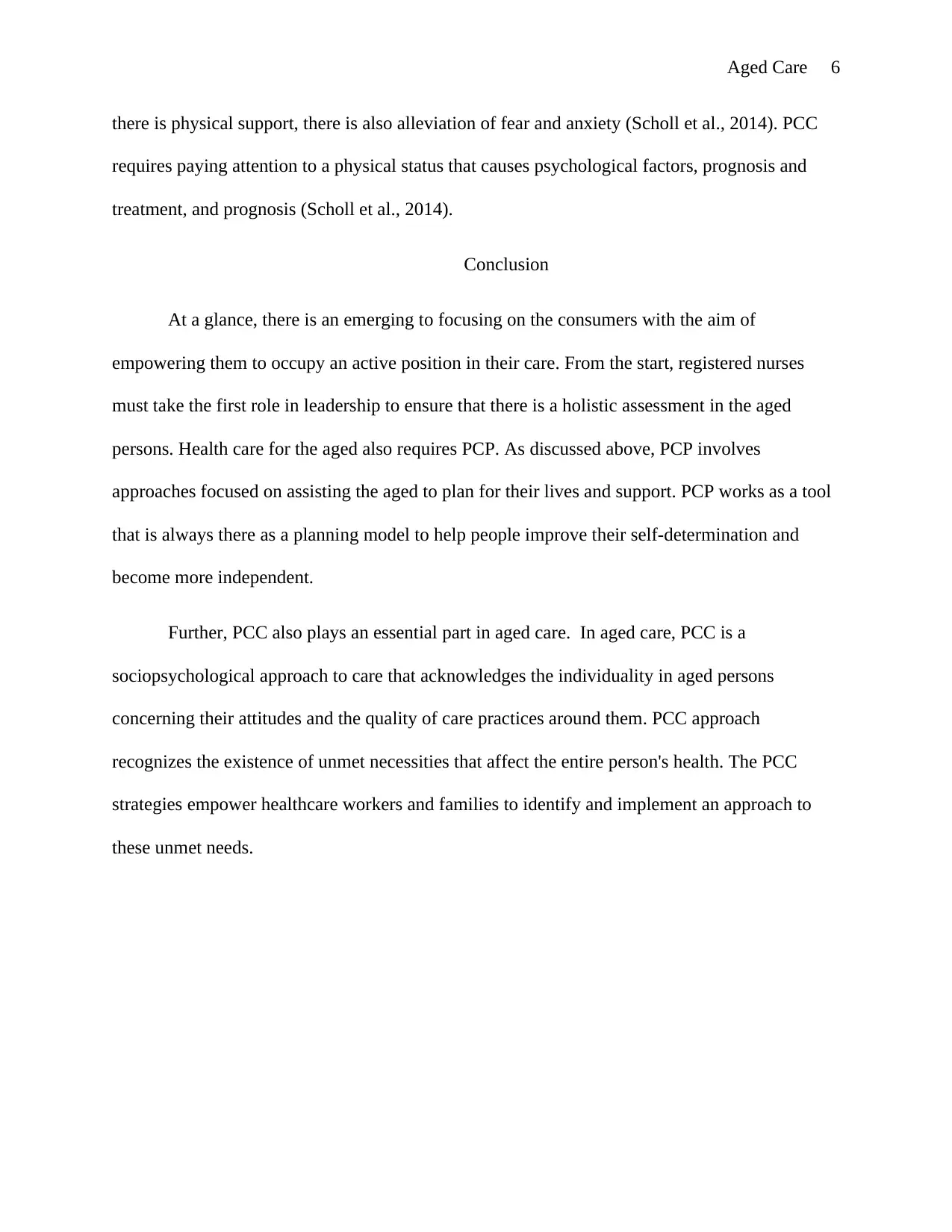
Aged Care 6
there is physical support, there is also alleviation of fear and anxiety (Scholl et al., 2014). PCC
requires paying attention to a physical status that causes psychological factors, prognosis and
treatment, and prognosis (Scholl et al., 2014).
Conclusion
At a glance, there is an emerging to focusing on the consumers with the aim of
empowering them to occupy an active position in their care. From the start, registered nurses
must take the first role in leadership to ensure that there is a holistic assessment in the aged
persons. Health care for the aged also requires PCP. As discussed above, PCP involves
approaches focused on assisting the aged to plan for their lives and support. PCP works as a tool
that is always there as a planning model to help people improve their self-determination and
become more independent.
Further, PCC also plays an essential part in aged care. In aged care, PCC is a
sociopsychological approach to care that acknowledges the individuality in aged persons
concerning their attitudes and the quality of care practices around them. PCC approach
recognizes the existence of unmet necessities that affect the entire person's health. The PCC
strategies empower healthcare workers and families to identify and implement an approach to
these unmet needs.
there is physical support, there is also alleviation of fear and anxiety (Scholl et al., 2014). PCC
requires paying attention to a physical status that causes psychological factors, prognosis and
treatment, and prognosis (Scholl et al., 2014).
Conclusion
At a glance, there is an emerging to focusing on the consumers with the aim of
empowering them to occupy an active position in their care. From the start, registered nurses
must take the first role in leadership to ensure that there is a holistic assessment in the aged
persons. Health care for the aged also requires PCP. As discussed above, PCP involves
approaches focused on assisting the aged to plan for their lives and support. PCP works as a tool
that is always there as a planning model to help people improve their self-determination and
become more independent.
Further, PCC also plays an essential part in aged care. In aged care, PCC is a
sociopsychological approach to care that acknowledges the individuality in aged persons
concerning their attitudes and the quality of care practices around them. PCC approach
recognizes the existence of unmet necessities that affect the entire person's health. The PCC
strategies empower healthcare workers and families to identify and implement an approach to
these unmet needs.
⊘ This is a preview!⊘
Do you want full access?
Subscribe today to unlock all pages.

Trusted by 1+ million students worldwide
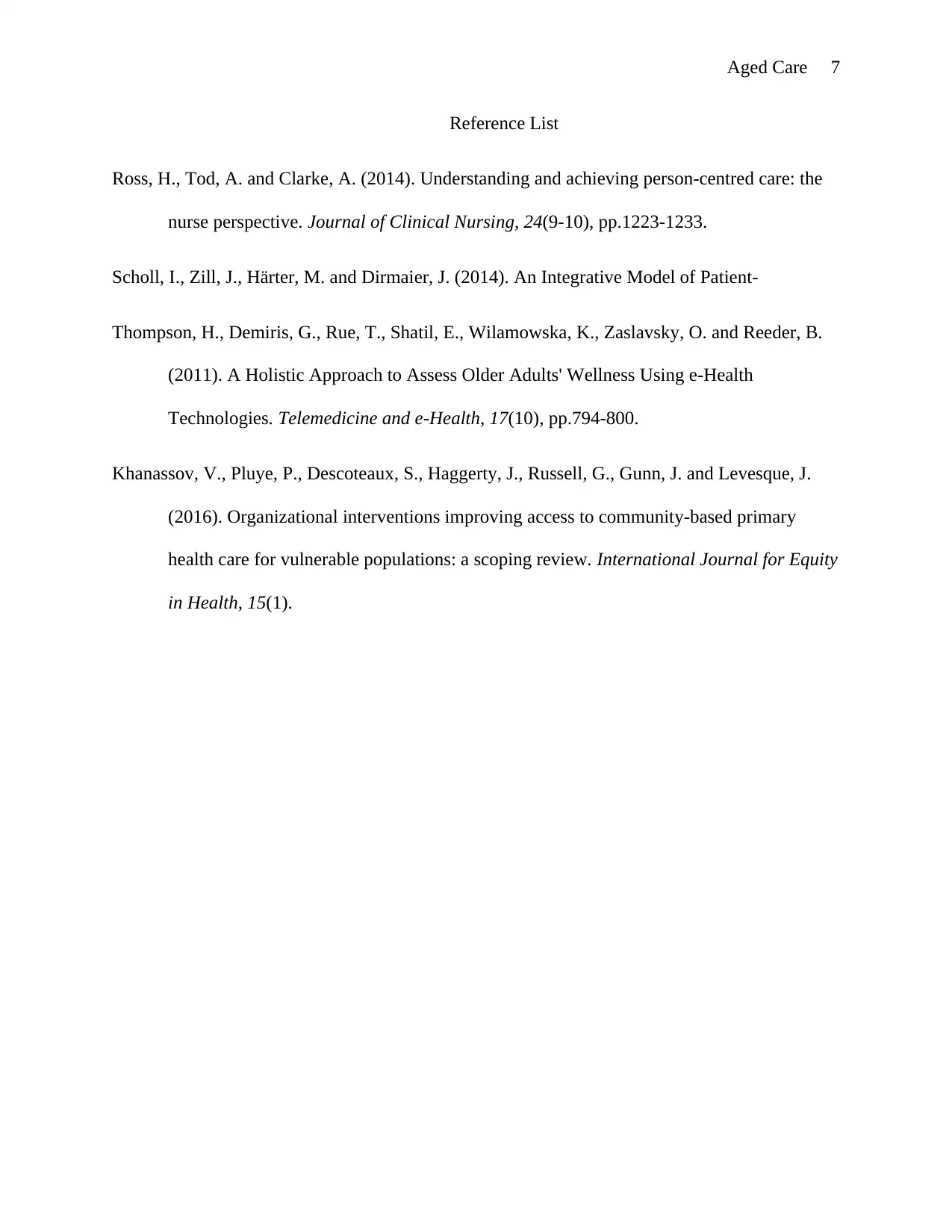
Aged Care 7
Reference List
Ross, H., Tod, A. and Clarke, A. (2014). Understanding and achieving person-centred care: the
nurse perspective. Journal of Clinical Nursing, 24(9-10), pp.1223-1233.
Scholl, I., Zill, J., Härter, M. and Dirmaier, J. (2014). An Integrative Model of Patient-
Thompson, H., Demiris, G., Rue, T., Shatil, E., Wilamowska, K., Zaslavsky, O. and Reeder, B.
(2011). A Holistic Approach to Assess Older Adults' Wellness Using e-Health
Technologies. Telemedicine and e-Health, 17(10), pp.794-800.
Khanassov, V., Pluye, P., Descoteaux, S., Haggerty, J., Russell, G., Gunn, J. and Levesque, J.
(2016). Organizational interventions improving access to community-based primary
health care for vulnerable populations: a scoping review. International Journal for Equity
in Health, 15(1).
Reference List
Ross, H., Tod, A. and Clarke, A. (2014). Understanding and achieving person-centred care: the
nurse perspective. Journal of Clinical Nursing, 24(9-10), pp.1223-1233.
Scholl, I., Zill, J., Härter, M. and Dirmaier, J. (2014). An Integrative Model of Patient-
Thompson, H., Demiris, G., Rue, T., Shatil, E., Wilamowska, K., Zaslavsky, O. and Reeder, B.
(2011). A Holistic Approach to Assess Older Adults' Wellness Using e-Health
Technologies. Telemedicine and e-Health, 17(10), pp.794-800.
Khanassov, V., Pluye, P., Descoteaux, S., Haggerty, J., Russell, G., Gunn, J. and Levesque, J.
(2016). Organizational interventions improving access to community-based primary
health care for vulnerable populations: a scoping review. International Journal for Equity
in Health, 15(1).
1 out of 7
Related Documents
Your All-in-One AI-Powered Toolkit for Academic Success.
+13062052269
info@desklib.com
Available 24*7 on WhatsApp / Email
![[object Object]](/_next/static/media/star-bottom.7253800d.svg)
Unlock your academic potential
Copyright © 2020–2025 A2Z Services. All Rights Reserved. Developed and managed by ZUCOL.





